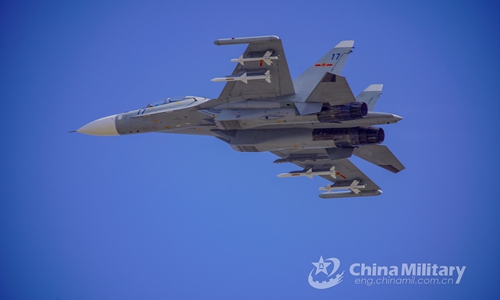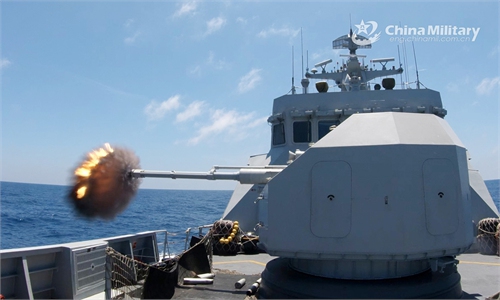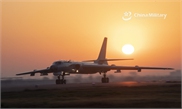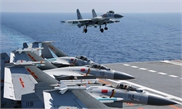PLA fighter jet breaks flight duration record in first 10-hour patrol mission to South China Sea

Pilots assigned to a naval aviation brigade under the PLA Eastern Theater Command keep their Su-30 fighter jet in a specified airspace while awaiting further clearance during an actual-combat flight training exercise in mid-February, 2020. (eng.chinamil.com.cn/Photo by Li Hengjiang)
By having a Su-30 fighter jet complete a 10-hour armed patrol mission to the most remote islands and reefs of the South China Sea, the Chinese People's Liberation Army (PLA) Air Force recently broke its record on flight duration in a single sortie by a fighter jet.
Both technically and mentally challenging, this kind of mission is of significant strategic value to the PLA's complete patrol coverage of the entire South China Sea, experts said Tuesday.
An aviation force brigade attached to the PLA Southern Theater Command Air Force completed the patrol mission in the South China Sea, mgtv.com, a news website under Hunan Television, reported on Monday.
Dubbed "Thunderbolt Eagle," the brigade's main mission objectives concern the South China Sea, and since a round trip patrol mission from its base to the most remote islands and reefs would need 10 hours, this kind of long endurance mission has become necessary, the report said.
The previous PLA Air Force flight duration record for a single sortie by a fighter jet was 8.5 hours, it said.
According to the report, the Su-30 fighter jet refueled mid-flight with an aerial tanker, and the pilots consumed rations to keep their energy up.
"During a flight, the body reaches a limit at four to five hours, so pilots will relieve stress and fatigue by chatting and eating flight rations, which includes mineral water and chocolate," mgtv.com quoted pilot Lu Geng as saying.
Wang Ying, another pilot on the mission, said in the report that the mission is not about breaking the limit or the record, but about real combat.
Chinese military aviation expert Fu Qianshao told the Global Times that a 10-hour patrol mission is challenging because the fighter jet's fuel capacity cannot support such a long flight, so aerial refueling is needed, which is technically challenging. A long-duration flight is also very stressful to the pilots, as they also need to stay on high alert during their mission.
The mission demonstrated that the PLA Air Force's long-range flight capability and the scope of its patrol operations have greatly expanded, Fu said, noting that large warplanes like H-6 bombers have previously conducted similar missions, but they were not fighter jets.
Fighter jets can escort bombers or conduct surveillance missions on aerial and surface targets on their own. This is of significant value in safeguarding China's national interests and aerial security, Fu said.
The PLA has deployed fighter jets directly to islands in the South China Sea in the past, reports said.
Forbes reported in July that the PLA deployed at least four J-11B fighter jets to Yongxing Island of the Xisha Islands. Previous reports also suggested the presence of J-10 fighter jets and JH-7 fighter bombers on the islands.
Fu said that fighter jets deployed on the islands can react faster, but that maintenance on the islands is more difficult due to high salinity and humidity, and the number of fighter jets would be limited since island bases are relatively small.
This is why the long-endurance patrol missions from Chinese mainland bases are still important, and both deployment methods can complement each other, Fu said.




